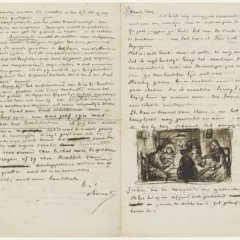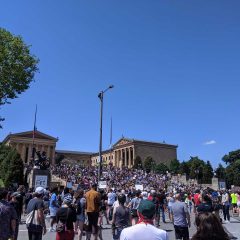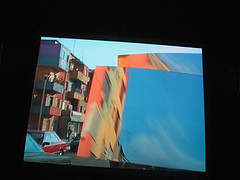
from The Landscape is Changing video
The video world is international, and there’s some terrific international video right now at the Philadelphia Museum of Art. Mircea Cantor’s (name pronounced Meer-tcha Con-tour) videos are paintings in motion, and that visual wizardry more than works to keep a viewer engaged along with sometimes mysterious, always engaging, subject matter (at least that was so in the two pieces I saw).
This exhibit, “Live Cinema/Mircea Cantor: The Title is the Last Thing,” at the PMA, is the most comprehensive showing of Cantor’s videos in the U.S.. Eight videos are showing (the schedule is here) plus some of his photographs and other art objects are on exhibit in the little video screening room (Gallery 179) from tomorrow until Feb. 11. And Cantor himself will be speaking with contemporary art Curator Carlos Basualdo and curatorial fellow Emily Hage tonight, 6 p.m. (talk info here).
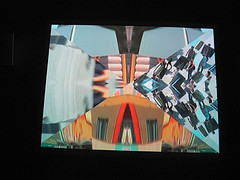
from The Landscape is Changing video
I stopped by the PMA yesterday to chat with Cantor, who is just the other side of being a kid at 29. He’s a wiry young man with coiled energy and short-short hair, in a rather tight-fitting shirt with a ’60s-style pattern. While I was confirming the internet information–born in Romania in 1977, lives and works in Paris–he said he’d prefer not to be pinned down to a place, because of people’s pre-conceived notions about what places mean. To prove the meaninglessness of place, Cantor said he’s in France on a Romanian passport.
“I live and work on the earth,” he said. “It’s important to unite on a more human level. It’s not fair in a way. I don’t want to say Romanian, French, a New Yorker. I am human, without geographic or political context.”
Ahem. The work has geographic and political context often, however. So I asked him about the politics in his work.
I think he winced, but politely answered about Deeparture, a video showing a deer and a wolf pacing around an empty gallery, that refers to Joseph Beuys‘ I Like America and America Likes Me.” Deeparture, he said, is “very political, but…no slogans, no elements of political language. It’s poetic. You can’t be independent. Whatever you do has to be political and economic.”
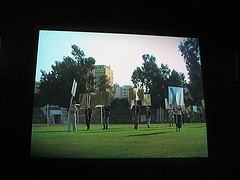
from The Landscape is Changing video
He then spoke about the video now on view, The Landscape is Changing, in which demonstrators carry wordless, mirrored placards. The piece was created for the Tirana Biennial (the guy has already been around the art world–here’s his bio). He said he had noticed how there wasn’t much difference between demonstrations for or against the government–“it’s the same dance.” So he made a neutral demonstration. “It was a way to not add another reality–just to reflect.” This by the way is a fabulous video. The visuals are mesmerizing, with aural and visual references to state control and to Rohrschach inkblots that imply left is right, right is left, and all of it depends on perception. (I was reminded of the Pedro Lasch mirrored masks at Temple Gallery, and suggested he see the work. I should have told him to check on the Jesper Just videos there, too–see post).
Cantor said he preferred that the videos be scaled much larger than they are in the small space at the museum, so “it’s big so the viewer can enter.”
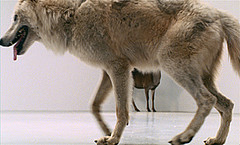
from Deeparture video. the animal in the back is a deer. I used this Museum photo because the video was disproportionately long while I was shooting; like at home, the remote had disappeared, but when it turned up at last, Cantor fixed the proportions.
He noted how Landscape has street sounds and big bass, while Deeparture is silent. He said he preferred to remain silent on what Deeparture was about.
Deeparture, which shows the two animals pacing around the Yvon Lambert Gallery in Paris, also showed in Yvon Lambert’s Chelsea Gallery, projected life-sized. Because the video was silent, “People came in quietly. The film allows you [to think] a lot of things. …Art is something like food. You eat it. If you don’t like it, you throw it away. Sometimes you need that one grain of flour. But how that one grain comes is not very easy.”
Then he went on about people’s response to Deeparture, their concern for the animals, and the pairing of a deer with a wolf. “We try too much to humanize the animal world. They will meet in the forest. Art is to reflect and not just a snapshot of reality that you document on the street.”
I asked the obvious–whether he was in the gallery with the animals to videotape them. He said yes, it was difficult for him.
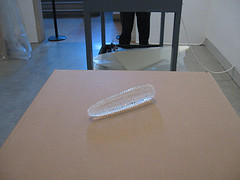
Diamond Corn, 2005, cast crystal
I asked about the beautiful glass ear of corn on a cardboard-carton pedestal. He made it for the Chelsea gallery, with 20 ears of corn, arrayed like in the market.
“I wanted to create a new value–corn as diamonds. I wanted to banalize the diamonds and noble-ize the corn.” The piece was influenced by a trip to Mexico where corn is such an important part of the life. He ruminated over the Mayan myth that human beings were born from corn. He said he liked the carton pedestal for the contrast in material.
I asked about his travels. On the internet there’s a lot of talk about his hitchhiking around Romania and his travel to France. He moved to France in 1999 to study, and was accepted in a Master’s program even though in Romania he was only in his second year. He’s still marveling over that–really the only moment in our talk when he put his guard down.
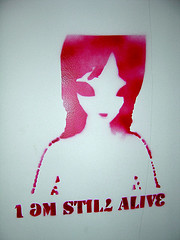
1-6M-ST1LL-ALIV3, stencil, spray paint, 2004
He answered everything reluctantly, maybe because he was anxious to buy spray paint to install his piece, “I am still alive.” While we were talking, preparators were working on his “I shot this image because it is highly suggestive within a specific circle,” a lightbox illuminated image of a pile of urinals in Romania–a salute to Duchamp, and of course, in Philadelphia at the PMA, we are part of that specific circle. Also on display is another salute to Duchamp, a check he wrote to pay his dentist–collector Philip Cohan.
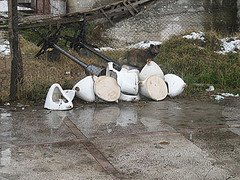
I shot this image because it is highly suggestive within a specific circle
Then he sprang up, escaping for the hardware store and the spray paint.
Here’s my flickr set for more images.



